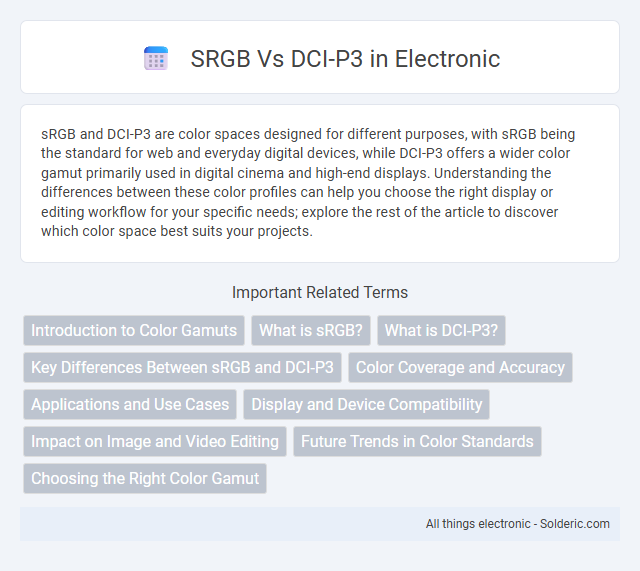sRGB and DCI-P3 are color spaces designed for different purposes, with sRGB being the standard for web and everyday digital devices, while DCI-P3 offers a wider color gamut primarily used in digital cinema and high-end displays. Understanding the differences between these color profiles can help you choose the right display or editing workflow for your specific needs; explore the rest of the article to discover which color space best suits your projects.
Comparison Table
| Aspect | sRGB | DCI-P3 |
|---|---|---|
| Color Gamut Coverage | Approx. 35% of visible colors | Approx. 45% of visible colors |
| Primary Use | Web, consumer displays, digital cameras | Digital cinema, high-end displays, HDR content |
| Color Space Type | RGB (Red, Green, Blue) | Wider RGB gamut |
| White Point | D65 (6500K) | D65 (6500K), sometimes DCI white point |
| Gamma | Approx. 2.2 | Approx. 2.6 (standard DCI gamma) |
| Compatibility | Standard for most devices, broadly supported | Increasingly adopted in HDR and cinema, less universal |
| Example Applications | Web graphics, office monitors, consumer TVs | Digital cinema projectors, Apple Retina displays, HDR TVs |
Introduction to Color Gamuts
Color gamuts define the range of colors a display or device can reproduce, with sRGB covering around 35% of the visible color spectrum, commonly used for web and consumer devices. DCI-P3 offers a wider gamut, approximately 45% of the visible spectrum, favored in digital cinema and high-end displays for richer and more vibrant colors. Understanding your color gamut needs ensures accurate color representation and enhances visual experience in your projects or media consumption.
What is sRGB?
sRGB is a standard RGB color space widely used for digital images and displays, ensuring consistent color representation across various devices like monitors, printers, and cameras. It covers a smaller color gamut compared to DCI-P3, making it ideal for everyday web and consumer content but less suitable for high-end digital cinema or professional applications. Your choice of sRGB guarantees widespread compatibility and accurate color reproduction on most screens and platforms.
What is DCI-P3?
DCI-P3 is a color space developed by the Digital Cinema Initiatives, designed to encompass a wider range of colors than sRGB, commonly used in digital movie projection and HDR displays. It covers approximately 25% more gamut than sRGB, delivering richer reds and more vivid colors, making it ideal for cinematic content and high-end displays. Your devices or content creators targeting DCI-P3 ensure more accurate and vibrant color representation compared to the standard sRGB gamut.
Key Differences Between sRGB and DCI-P3
sRGB covers approximately 35% of the visible color spectrum and is the standard color space for web and consumer-grade devices, ensuring consistent color reproduction across digital platforms. DCI-P3 offers a wider gamut, covering about 45% of the visible spectrum, making it ideal for digital cinema and high-end displays that require richer, more vibrant colors. Your choice between sRGB and DCI-P3 depends on whether you prioritize broad compatibility or enhanced color accuracy for multimedia content.
Color Coverage and Accuracy
sRGB color space covers approximately 35% of the visible spectrum and is widely used for standard monitors and web content, offering consistent color accuracy across various devices. In contrast, DCI-P3 covers about 45% of the visible spectrum, encompassing a broader range of reds and greens, which enables more vibrant and lifelike color reproduction, particularly for digital cinema and high-end displays. Devices calibrated to DCI-P3 deliver enhanced color accuracy for HDR content and wide-gamut workflows, making it the preferred choice for professional video and photography applications.
Applications and Use Cases
sRGB is the standard color space for web content, digital photography, and most consumer displays, ensuring consistent color reproduction across devices. DCI-P3 offers a wider color gamut ideal for professional video production, digital cinema, and high-end displays, providing richer and more vibrant colors. You should choose sRGB for everyday use and online content, while DCI-P3 is preferred for tasks demanding enhanced color accuracy and cinematic quality.
Display and Device Compatibility
sRGB remains the most widely supported color space across displays and devices, including smartphones, laptops, and web content, ensuring consistent color reproduction. DCI-P3 offers a wider color gamut suitable for high-end monitors, HDR TVs, and professional video editing devices, but its compatibility is limited outside specialized hardware. To achieve optimal color accuracy, you should match your content's color space with the display's supported gamut.
Impact on Image and Video Editing
sRGB covers a smaller color gamut compared to DCI-P3, which offers richer and more vibrant colors, making it ideal for high-end video and image editing. Using DCI-P3 allows you to achieve more accurate color reproduction and better detail in highlights and shadows, crucial for professional content creation. Choosing the right color space directly affects the quality and realism of your edited images and videos, ensuring they look consistent across different displays.
Future Trends in Color Standards
Future trends in color standards indicate a shift from sRGB towards wider gamuts like DCI-P3, driven by advancements in display technology and content creation. DCI-P3, covering approximately 25% more color space than sRGB, offers richer, more vibrant visuals, making it essential for next-generation monitors, smartphones, and HDR content. To ensure your digital media remains visually compelling and future-proof, adapting to DCI-P3 is becoming increasingly critical as industry adoption accelerates.
Choosing the Right Color Gamut
Choosing the right color gamut depends on your device's intended use and display capabilities. sRGB is the standard for web and general consumer content, offering consistent and widely supported color reproduction. DCI-P3 provides a wider color range suited for cinema and high-end devices, enhancing vibrancy and color accuracy for professional video and digital art.
sRGB vs DCI-P3 Infographic

 solderic.com
solderic.com